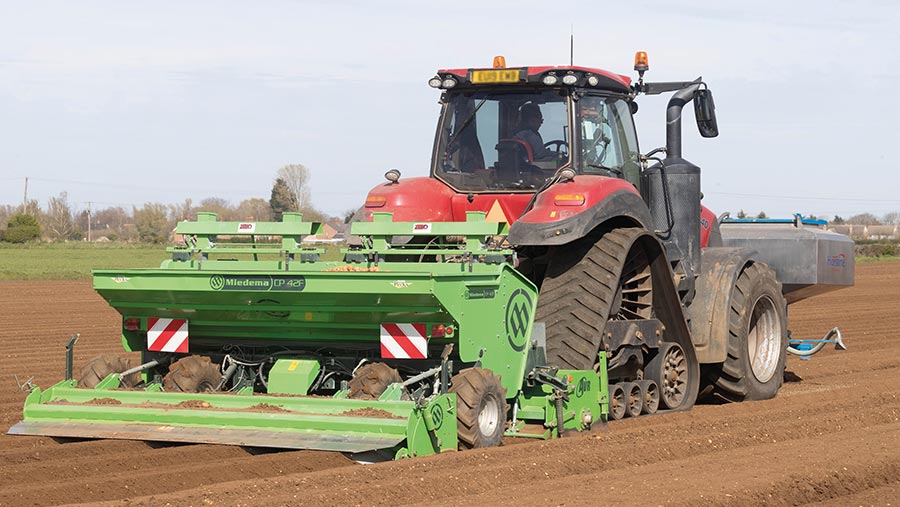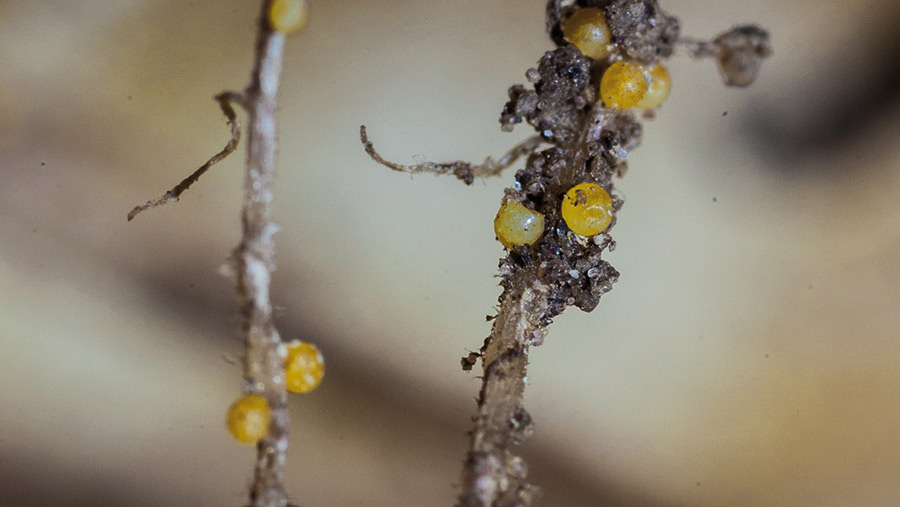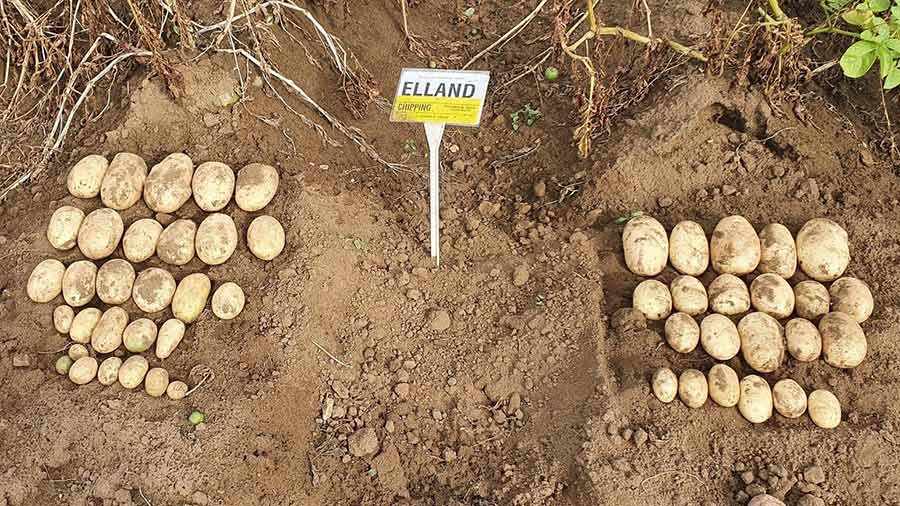How potato variety choice helps with nematode management
 © Tim Scrivener
© Tim Scrivener The significant threat posed by potato cyst nematode (PCN) in many potato-growing areas is making variety choice a key component of a sustainable production system.
With nematicides facing an uncertain future, varieties that offer both resistance and tolerance to the dominant nematode species, Globodera pallida, are becoming part of the solution.
See also: How to grow potatoes using minimal tillage
In Scotland, the area of land infested with G pallida is doubling every seven to eight years, putting both the seed and ware industries at risk, warn industry experts, who point to a historic lack of availability of suitable resistant varieties for those markets.
Of the varieties available, almost all are for processing and not acceptable for ware, with some of them not having the tolerance that is required along with resistance for protecting yield and profit, explains Alistair Redpath, director of independent potato breeder Cygnet PB.
“We’ve seen varieties appear that have very good resistance to G pallida, but no tolerance,” he says “While they do help to reduce nematode populations when planted on infested land, they don’t yield.”
Where a variety has confirmed tolerance as well as good resistance, the outcome is very different, he adds. “If these are grown, there’s a reduction in egg numbers per gram of soil and good yields. Growers want to have them in the mix.”
Dual-purpose variety
Cygnet PB’s dual-purpose variety Elland has shown to be both resistant and tolerant on sites with G pallida infestation in independent trials conducted over the past few years.
Also accepted by McCain in England for chip production, commercial quantities of seed have been available this year.
With its suitability for fresh and processing uses, Elland’s introduction comes at a time when chemical control options are under intense scrutiny, input costs are rising and there’s far greater emphasis on sustainability.
“The dynamics in Scotland are changing,” notes independent potato agronomist John Sarup.
“We know that there’s been an uplift in G pallida infestations, which is creating difficulties for both the seed and ware industry north of the border.
“The focus is shifting to the help that genetics can bring in cleaning up contaminated land, preventing further spread and future-proofing potato production.”
The current state of play developed when varieties with resistance to the other main nematode species G rostochiensis appeared, he explains, as putting them into rotations meant that growers were unintentionally selecting for G pallida.
That resulted in land that had been used for seed, much of which is rented, becoming unsuitable.
“The other main form of control, the use of a nematicide, is generally less effective on G pallida,” comments Mr Sarup.
“Its life cycle means that they hatch a bit later, which often coincides with when the nematicide applied starts to run out of steam.”
Non-chemical control methods will become increasingly relevant, he believes, with the environmental profile of potato varieties and soil health moving up the supply chain’s agenda.
Scottish Agronomy trials

© Blackthorn Arable
Scottish Agronomy has done trials looking at a number of varieties with good G pallida resistance, reports senior agronomist Eric Anderson, both for its farmer members and for the Scottish government’s Plant Health Centre report on PCN.
In that work, Elland proved to also have very useful tolerance to the pest, making it one of a handful of varieties to offer the combination, he confirms.
“In our trials, we compared varieties with and without the use of a nematicide. Those without tolerance did help to reduce PCN populations, but didn’t produce the yields if a nematicide wasn’t used.”
The work was done on a droughty site, so yields were generally low.
Elland gave 37.46t/ha where Nemathorin (fosthiazate) was used and 34.36t/ha without it, with egg numbers per gram of soil being reduced to very low levels – showing the combined effect of resistance and tolerance.
As well as its role in helping to reduce PCN populations and restrict multiplication, Elland is more than suitable for the ware market, believes Mr Anderson, who says there is an urgent need for a pre-pack variety that’s suitable for growing in Scotland.
“It’s good to see varieties like this coming through,” he says. “Genetics are really important in an Integrated Pest Management strategy, which must also include the control of potato volunteers.”
Looking ahead, Mr Anderson stresses that this type of variety needs be taken seriously by supermarkets and the packing industry as well.
“Potatoes will have to be grown in a 13-year rotation if we can’t manage PCN populations in a more sustainable way.”
Grower experience: Edward Backhouse, Goole

Edward Backhouse © Dave Franciosy Farming Photography
Yorkshire grower Edward Backhouse grew a trial area of Elland last year and found that the new variety yielded and stored well – both important characteristics for the chip shop market that he supplies.
With very low potato cyst nematode numbers on the farm requiring infrequent nematicide use, he is keen to keep it that way.
Mindful that the chemical options are under threat, varieties that help with nematode management give him another option.
“We have a good one-in-10 rotation and most of our land is clear, but the loss of any more nematicides would be a blow,” he says.
Growing 88ha of potatoes on his farm near Goole, Mr Backhouse looks for varieties that yield well, can be stored and offer PCN resistance, so he is always interested in new ones that combine these characteristics.

Cygnet Potato Breeders
“We tried a couple of tonnes of Elland for our chipping outlets last year, which went well in terms of growing and storing, so we have 8ha going into the ground this year,” he says.
His main variety, Sagitta, doesn’t offer PCN resistance and isn’t as good for long-term storage.
“For the chip shop trade, we start selling potatoes from October onwards, with loads going every week until June,” he explains.
“So the ability of a variety to store well for that period of time matters.”
The chip shop market is dominated by a handful of favourite varieties, he adds, some of which are susceptible to PCN.
Getting new varieties accepted can take time, but it’s in the whole supply chain’s interest to make resistant varieties work.
“We also grow some Eurostar, so would like to replace that with Elland in due course.”
Elland is suitable for factory processing as well as chip shop use, he points out, so there are other market options and he is aware that McCain is using the variety.
“The tubers are a nice size and shape,” says Mr Backhouse. “Pending the results of taste tests, Elland should also interest the pre-pack sector.”

